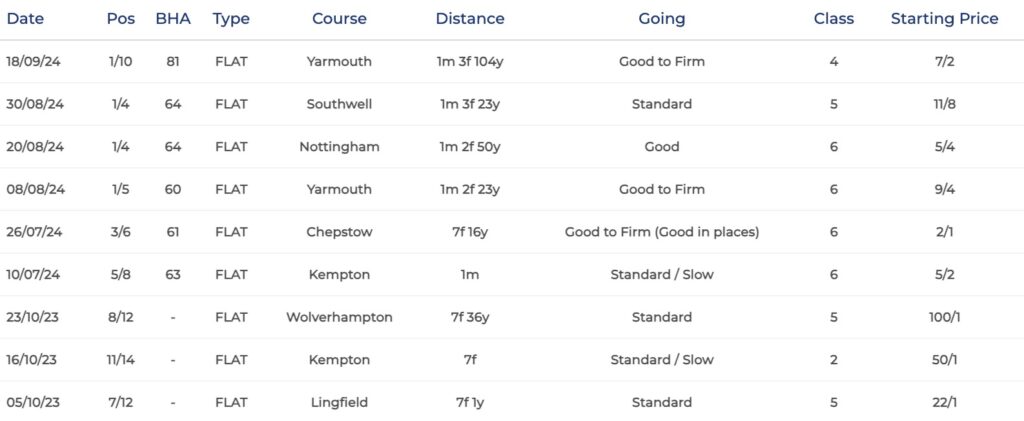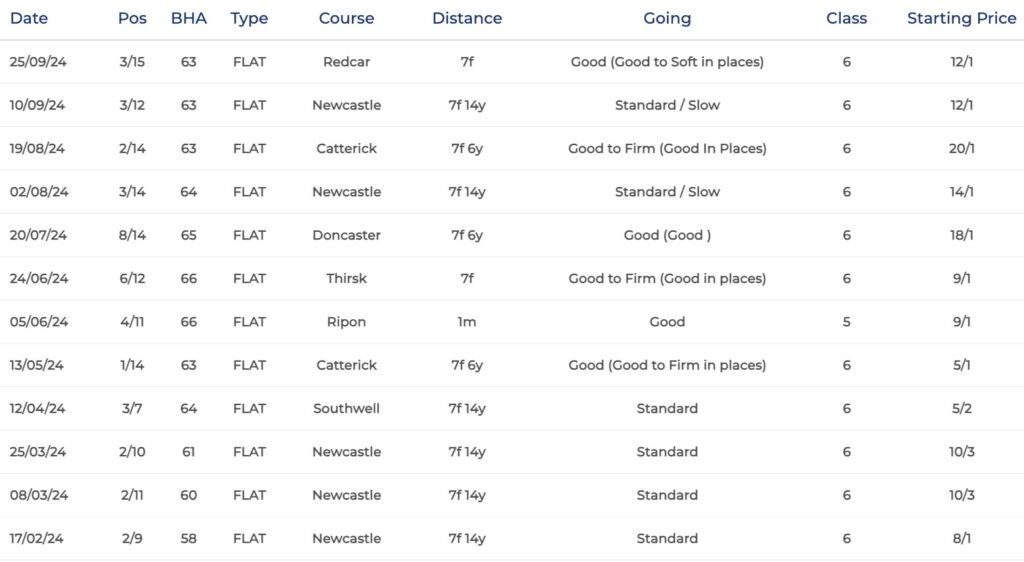In this article…
🐎 What Are Handicaps?
Handicaps in horse racing are the most common type of race you will see, making up over 6,000 races in the calendar year. With so many opportunities to choose from, navigating and understanding the make-up of a handicap race and what to look for can set you up for better-informed betting decisions.
Simply put, a handicap race is a way of levelling the field so that (on paper) all horses have the ability to race competitively in the same race. Weight allocations are given to all horses based on a handicap rating, which they usually receive once they have run three times in their career.
From here, when entering handicaps, the horses with the highest handicap rating in the race will carry top weight, and the horses with the lowest rating will carry bottom weight. Thus creating (in theory) an equal playing field.
Pay attention to the ‘WGT/OR’ column below, as the OR (Official Rating) increases, the WGT (Weight the horse must carry) increases too. For example, Veydari is rated 71 and will carry 9st-1lbs in this particular race, while Top Juggler is rated higher at 79, so will carry 8lbs more (9st-9lbs).

A handicapper is assigned to a group of horses where it is his job to assess those horses and alter their handicap rating on a weekly basis. Through time, the rating will become an accurate representation of the horse’s form, where you can build a case for when a good opportunity arises to put your money down on certain horses at certain marks.
However, it’s not uncommon to see the handicap system played and horses running off incorrect marks due to their performances not being transparent.
This guide will explain the ins and outs of horse racing handicaps and how you can use it to your advantage when betting on horse racing. We also have further guides on each-way betting and ante-post betting that you may find useful.
We love our racing here at Andy’s Bet Club so be sure to check out our free horse racing each-way tips and free horse racing tips articles, offering insight from our Hit Rates and Racing Ratings tools respectively. Don’t forget that all of our predictions can be easily found on our horse racing tips page.
There’s also Tuesday Trixie tips and Saturday’s win double and each-way tips available every week, whilst you can be sure you’re getting the best deal when you back our tips with these horse racing free bets and sign up offers.
🕵️ What to Look For in Handicaps
Horses who have recently acquired their handicap rating are of interest and are worth watching (not necessarily backing) in their first few starts in handicaps, so you can make your own invested decisions on whether they were produced to their full potential at the beginning of their careers.
Handicappers can make errors, and it generally translates into horses winning by wide margins in handicaps. An example of this is shown below from a three-year-old filly called Overture at the beginning of her career.

As you can see, the filly was given a rating of 63 at the beginning of her career and ran twice at the start of 2024 in handicaps before going on to dominate races at Yarmouth (1½ lengths), Nottingham (5½ lengths), and Southwell (3½ lengths), all racing off similar marks.
Winning again off a mark of 81, there is a dramatic difference between her opening mark of 63 and her now mark of 88 after winning by a neck in September. Was she running to her full potential at the start of her career? Identifying these types of horses early before the handicapper catches up with them can be a great route to finding hidden gems.
🎙️ “Has Ran Well Off This Mark”
When watching racing, you have probably heard the phrase “has ran well off this mark.” This is key information about horses in handicaps who haven’t been performing off their increased mark.
A horse can have their mark reduced through running poorly or returning from lengthy absences in a bid to keep the competitiveness of handicaps true. Below is a screenshot of Saisons D’Or who is performing well this year off a mark of 63 or less but struggles off anything over 64.

Winning off a mark of 63 in May, Saisons D’Or has struggled with his newly increased mark, but after returning to a mark of 63 in his last three races, he has gone close on all three occasions at big prices. Racing off 63 again next time out, “he has ran well off this mark” and is one for the shortlist on his next outing.
🏇 Claiming Jockeys
A lot of punters overlook quality horses based on the jockey in the saddle and will opt to follow Oisin Murphy, William Buick and co blindly. A claiming jockey is an amateur rider who receives a weight allowance depending on how many winners they have ridden in their career and differs between flat at jumps.
| Apprentices (flat racing) | Conditionals (jumps rules) |
|---|---|
| – 7lb until they have won 20 races | – 7lb until they have won 20 races |
| – 5lb until they have won 50 races | – 5lb until they have won 40 races |
| – 3lb until they have won 95 races | – 3lb until they have won 75 races |
People avoid claimers due to the fact they are less experienced but find a good claimer, and they are worth their weight in gold for lightening the load on your selection. The now well-known Billy Loughnane was a rare find at the age of 16 who rode out his claim just 11 months from his debut (95 wins in a season).
Scoring for 35 different trainers proves you can’t tar all claimers with the same brush, and there are some good ones out there that can enhance your picks!
📺 Watch The Races Back
Jockeys and trainers are always trying to get one up on the handicapper and looking for ways to increase their chances of future victories. If you don’t physically watch previous races, you are immediately putting yourself at a disadvantage when looking to back winners. When checking the results, you will see the winning margins of horses, but they are not always a true reflection of how the horse actually ran.
Sometimes jockeys can attempt to lessen the winning margin to fool the handicappers, and it is not always immediately obvious. On paper, a horse can go down as winning by a neck when it should have won by half the track. This also works when jockeys don’t put horses in the race in a bid to lower their handicap mark and without watching previous races, you are missing out!
Summary
There are many ways to skin a cat and with so many variables making up a handicap race, it is key to understand the dynamics of how they work to give yourself the best opportunity of making a profit from these races.
Now you should have a better understanding of the handicap system within horse racing, and that should boost your betting skills.
Good luck with your punting!
Written by an Andy verified content writer
18+ please gamble responsibly.















